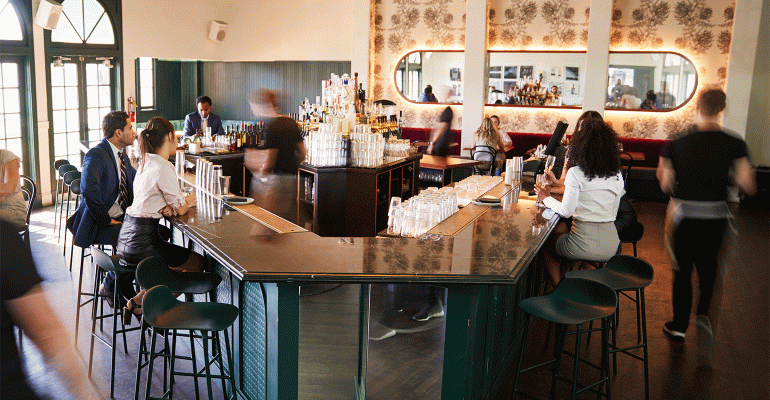The U.S. foodservice industry is expected to reach $898 billion in sales this year, returning to pre-COVID pandemic trajectory, the National Restaurant Association said in its 2022 State of the Restaurant Industry report released Tuesday.
The Washington, D.C.-based association, in the new report that’s available for download, noted that foodservice sales remain, in inflation-adjusted dollars, about 11% below where they were before the COVID-19 pandemic was declared in March 2020.
“What we did this year is include a deflated a look at total industry sales because menu price inflation has been running at such an aggressive rate during the pandemic,” said Hudson Riehle, the association’s senior vice president of the research and knowledge group, in an interview Monday. “When you deflate it in terms of real gains, it's still down by well over 11%. That's still a hefty number.
Wholesale food costs were up 7.9% in 2021 and hourly labor costs in eating and drinking places was up about 8.6% for the year, he said.
Two years ago, the association’s forecast at the end of February 2020 was for the industry to reach $889 billion in sales in 2020, an anticipated 4% increase from $864 billion in 2019. But pandemic restrictions choked sales in both 2020 and 2021, and many effects linger into this year.
The association released a mid-year report in August last year that projected sales to reach $789 billion in 2021, up nearly 20% from 2020. The increase was bolstered by increased consumer confidence, pent-up desire and people returning to work.
Riehle said 2022 sales will be better than 2021, even though the last half of the past year saw consumers retrench, a trend that spilled into January.
“It's still the year of transition,” Riehle said of 2022, “but the path is directionally correct.”
Among other benchmarks anticipated this year:
- The foodservice industry workforce is projected to grow by 400,000 jobs, for total industry employment of 14.9 million by the end of 2022.
- More than half of surveyed restaurant operators said it would be a year or more before businesses conditions return to normal. They also expect food, labor and occupancy costs to remain elevated and continue to impact profit margins in 2022.
- 96% of operators experienced supply delays or shortages of key food or beverage items in 2021 and expect these challenges to continue in 2022.
- Pent-up demand for restaurant dining has increased, with 51% of surveyed adults saying they weren’t eating at restaurants as often as they would like — an increase of six percentage points from before the pandemic.
“The restaurant and foodservice industry has adapted and is carrying on with absolute resilience, so we’re optimistic about the path toward recovery in the coming year,” said Marvin Irby, interim president and CEO of the National Restaurant Association, in a statement. “We still have work to do to ensure that those operators struggling the most can survive.”
Riehle noted that consumers show a willingness to spend money in the industry.
“Operators are pretty ingenious about rapidly developing not only new business models but also tapping into the important and emerging different demographic differences,” he said.
Differences in how age groups expect to use restaurants in the future was a dramatic, with younger Gen Z and Millennial patrons anticipating restaurants to provide new offerings, Riehle said.
Those offerings, he said, “could be alcohol to go. It can be outdoor dining. It can be meal subscriptions, even meal kits, loyalty programs, technology usage and eco-friendly packaging.”
“How they use restaurants, what they expect from restaurants, is dramatically, dramatically different than the Gen Xers and the Baby Boomers,” Riehle noted.
The association report found more than eight in 10 operators said technology in a restaurant provided a competitive advantage, be it smartphone app ordering, reservations, mobile payment or delivery management.
Operators expect staffing to remain a challenge. While the restaurant and foodservice industry added back 1.7 million jobs during 2021 for an end-of-year total of 14.5 million employees, seven in 10 operators across all major segments reported being severely understaffed. The association said that will continue to constrain industry growth in 2022.
The association said that between 2023 and 2030, the industry is projected to add an average of 200,000 jobs each year, with total staffing levels reaching 16.5 million by 2030.
Restaurant “traffic has suffered immensely over this two-year period,” Riehle said. “And because of the higher inflationary environment, it's really put pressure on profitability.”
Recent association surveys found four out of five restaurant operators reported that they were less profitable now than they were before pandemic, Riehle said. “And the margins were not that great pre-pandemic for the typical restaurant operator. It was 3% to 6% of sales. So even pre-pandemic, there wasn't a lot of maneuverability regarding dealing with higher input costs.”
The resiliency of operators has been on full display during the pandemic, Riehle said, adding: “How they survived and adapted in this environment is Herculean.”
Contact Ron Ruggless at [email protected]
Follow him on Twitter: @RonRuggless

